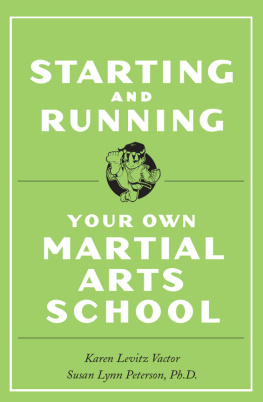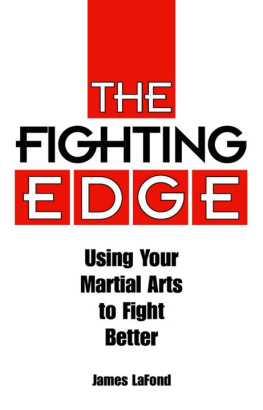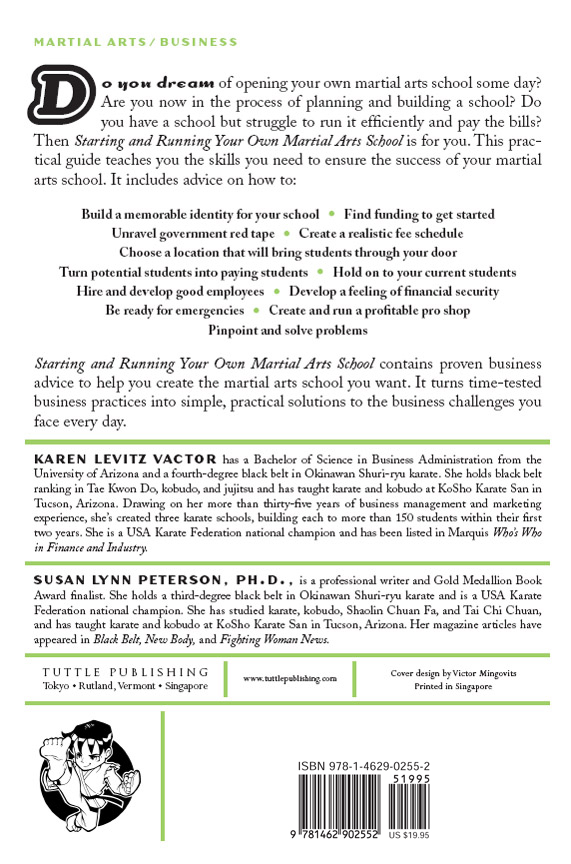A CKNOWLEDGMENTS
Many people have touched our lives and helped us grow in knowledge and spirit along the way. Some are close friends, others just passed through our lives leaving a significant impression behind.
Some of these people have been specifically helpful to this project, and we wish to thank them here.
We both would like to thank our husbands, Drew Vactor and Gary Peterson. Drews business insights and editing help were invaluable in the final stage of the project. His willingness to put off work on his own book allowed us the time we needed to finish ours. Garys flexibility makes a writers life possible. And his suggestions for the source of the title were, if not plausible, at least a source of much-needed comic relief. Their patience, good humor, and support made it possible for us to complete this book.
We appreciate the support and encouragement we received from Hanshi George Anderson, Shihan Johnny Linebarger, Shihan Patrick Hickey, Shihan Pam Hickey, Sensei Lend McCaster, Sensei Thomas Linebarger, Sr., Sensei Melvin Dilts, and Sensei Judith Robinson.
Karen especially wants to thank her father, Sam Levitz, pioneer of the warehouse-showroom style of selling furniture, who introduced her to the wonderful world of retail at a young age. He taught her patiently and well, generously sharing his insight along with his fatherly wisdom. A warm thank you to her mother, Lee Levitz, who instilled in her a sense of wonder and adventurism that guides her daily, and who taught her to always believe in herself.
Susan especially wants to thank the writers of the CompuServe Writers Forum. Their insights on everything from semicolons to publishing contracts, book titles to creative health have been invaluable. She also wants to thank her parents, Donald and Shirley Johnson, for their continued support.
Our thanks also to:
Bette Martin, our photographer and good friend. Donald C. Brandenburgh, our literary agent. Charlotte Wood, owner of Talking Book World, Tucson, for her insights into the SBA loan process. Melinda Williams for her insights into balance sheets and accounting. Dayna Macy of Nolo Press, and Ardella Ramey of Oasis Press, who provided research materials.
C HAPTER O NE :
B UILD A S UCCESSFUL M ARKETING I DENTITY
Your marketing identity is the face your business presents to the public. It contains the benefits you have to offer to a prospective student. It reflects your image, the way you project the things you believe in. It contains the things that best distinguish you from your competition. Your marketing identity is the foundation for all your advertising, for the way you approach prospective students, even for the way you decorate your school. It is your single most important marketing tool.
Focus on Your Image
Rule number one of marketing: people buy on emotion, on instinct. That doesnt mean all consumers are irrational. It just means that if people are going to spend hard-earned money on something, they are going to want to feel good about doing so. How often have you purchased something on a whim, just for the fun of it? How often have you relied, at least in part, on instinct or street smarts to tell you if what you were looking at was a good deal or a fraud? Your potential students do the same thing.
Your Schools Image
When developing a marketing identity you must first ask yourself what image you want to project. What image do you want for your school? When prospective students talk to you for the first timewhen they hang up the phone or walk out the doorhow do they feel? Is that how you want them to feel about you? How can you get them to know in their gut that studying with you is the right thing to do?
Before you dismiss image as some artificial advertising fiction, think about the teachers you have studied with. Were they people of integrity? Did they care about the well-being of their students? Whether you answered yes or no, how could you tell? You could tell by the way they conducted themselves, the way they managed their school. You could tell by the way their walk matched their talk. That, in its simplest form, is image.
If you believe in honor and integrity, the individual decisions you make about your business must reflect that honor and integrity. If children are important to you, you should show that in your day-to-day dealings with them. If you value strength tempered by self-control, if that is what you teach your students, ask yourself whether you project that value in your daily dealings with people. Looking at image is a reality check: Do your walk and talk reflect the things that are valuable to you?
If you are both the teacher and the owner of your school, about 60 percent of your schools image will be a reflection of your personality. The other 40 percent, however, will come from choices you make for your business. These choices will eventually give your business a personality of its own. Just as your personality comes through in your choice of clothes, the way you wear your hair, the way you speak to others, your business personality comes through in the way it looks and feels to others.
When examining your image, consider what target market you wish to attract. Your target market is the people you want to serve. Who is likely to want to study with you? To define your target market, think in terms of age, gender, marital status, and disposable income. These characteristics are called the demographics of your target market. Think about your preferences, but also think about the kind of people your art has attracted in the past. Talk to other martial arts school owners in your city about whom they teach. If your style has a national organization, check with them on their demographics. If your style has very few children (or adults), very few people in urban (or rural) areas, very few people with incomes over (or under) a certain level, there may be good reasons for those demographics. If you plan to attract a target market different from what your art usually attracts, make sure you have good reasons to support that choice.
A word on choosing children as your target market: if you want to teach children, your target market will be the children, yes. But it will also be the parents of those children. Specifically, your target market will be young adults with children and the disposable income necessary to enroll them in your school.
Your target market should be defined by the image you choose. If your target market is young children, you probably dont want to present yourself as a school for serious hand-to-hand combat. If your target market includes mostly soldiers from a nearby army base, teaching playground self-defense is silly.
In your idea notebook, describe your schools imagethe way you want to come across to students and prospective students. Who is your target market? Do you want to come across as a school where the whole family is welcome? Or do you teach mostly children? Or perhaps are you directing your services at just adults, or just a certain group of adults? Look at the choices you have made for your school. Do you want to create an image of stability and permanence, or do you want to look lean, mean, and highly mobile? Do you want a large school with a dozen teachers, a midsized school with you and an assistant teacher, or a handful of students who become like a family to each other? Are you a place where people can work out at their own level and have fun, or are you a training ground for serious martial artists relentless in their pursuit of excellence? If a reporter were to do a feature article about your school, what would you like to read in it? Finish this sentence: (Name of your school) is a school that _____________. Get as detailed as you can. Remember that the more detailed you can get now, the easier it will be to use the information in your marketing identity later.















